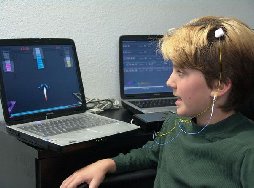 EEG is the name we’ve given to the wave like patterns we see when we amplify and record the electrical activity in our brain. Just as we can record the wave like pattern of our heart beat which we do in a recording called an EKG, we can record similar but different wave patterns in our brain’s electrical activity, which we call our EEG. The correlation between the frequency components of the EEG (electro-encephalogram) and a person’s state of arousal, their alertness, stability and flexibility, has long been observed.
EEG is the name we’ve given to the wave like patterns we see when we amplify and record the electrical activity in our brain. Just as we can record the wave like pattern of our heart beat which we do in a recording called an EKG, we can record similar but different wave patterns in our brain’s electrical activity, which we call our EEG. The correlation between the frequency components of the EEG (electro-encephalogram) and a person’s state of arousal, their alertness, stability and flexibility, has long been observed.
Genetic patterns, illness, stress, trauma, drug use and even weather or time of day, effects and changes our EEG. Dramatic changes in our EEG represent changes in the set point of the central nervous system, the part of us comprised of our brain and our spine, with the many nerve endings that connect from here to the rest of our body.
 Dis-regulated states that can be seen in the frequencies of our EEG wave patterns are an expression of some type of physical or mental disorder or difficulty. For us internally, as human beings, this dis-regulated wave pattern is experienced as some kind of discomfort, distress, or barrier in our human capacity to function and develop.
Dis-regulated states that can be seen in the frequencies of our EEG wave patterns are an expression of some type of physical or mental disorder or difficulty. For us internally, as human beings, this dis-regulated wave pattern is experienced as some kind of discomfort, distress, or barrier in our human capacity to function and develop.
We all have these elements of disruption in our wave pattern frequencies. It is when we experience mental or physical pain or impairment that disrupts or interferes with our lives that we sit up and take notice. Although there are applications of neurofeedback to enhance optimal performance for artists and athletes, for our purposes we are looking at ways to work with our EEG wave frequencies to increase flexibility and stability in pursuit of symptom reduction and healthy development throughout the life span.
In working to change your brain frequencies with EEG neurofeedback you may be shifting a frequency to help a particular part of your brain to better fulfill its individual functions, or you may be changing your frequencies to allow various parts of your brain to speak more clearly to one another and work better as a team. All of this can be more clearly understood in conversation with you provider or in readying about EEG neurofeedback.
Neurofeedback has a growing body of research to support its claims of efficacy. There are studies to support its usefulness for problems in attention, learning difficulties, affective disorders, trauma, epilepsy, chronic pain and addictions, as well as growing research in of other areas.
For more information on EEG neurofeedback see Education and Information Page
About Neurofeedback at aboutneurofeedback.com
EEG Education and Research at eegspectrum.com
ISNR, International Society for Neuroregulation and Research at isnr.org
Optimal Brain Institute, Northampton MA, at Optimalbrain.com
Dr. Ed Hamlin, Neuropsychologist, Neurofeedback Instructor and Consultant at The Center for the Advancement of Human Potential, Ian-asheville.com
Sebern Fisher at Sebernfisher.com Neurofeedback Provider, Instructor, Consultant and Author of:
Calming the Fear Driven Brain: Neurofeedback and Treatment of Developmental Trauma Disorder.
